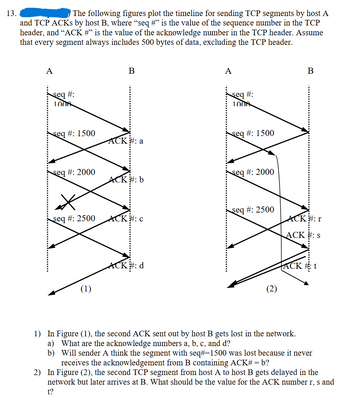
Concept explainers

This scenario involves the exchange of TCP (Transmission Control Protocol) segments and ACKs (Acknowledgments) between two hosts, Host A and Host B, over a network. TCP is a fundamental protocol used for reliable data transmission in computer networks. TCP segments carry data between hosts and are accompanied by ACKs to confirm the successful receipt of data.
In this discussion, we analyze two specific figures illustrating the sequence of events between Host A and Host B:
Figure (1): This figure depicts a situation where an ACK sent by Host B goes missing in the network. We need to determine the acknowledgment numbers corresponding to various segments and assess whether Host A perceives the loss of a specific segment.
Figure (2): In this scenario, a TCP segment from Host A to Host B experiences a delay in the network but eventually reaches its destination. We aim to establish the appropriate acknowledgment numbers for this situation.
Understanding these scenarios is crucial for grasping the behavior of TCP in real-world network environments, including how acknowledgment numbers are managed, how missing ACKs impact data transmission, and how delayed segments are handled by TCP.
Step by stepSolved in 4 steps

- If the destination port field of a TCP segment contains the binary number 0000000001010000 what protocol is being used?arrow_forwardIf the TCP and IP headers contain no options, what will the MTU be given a MSS value of 492?arrow_forwardSuppose the sequence number field on a TCP packet is 46005. The packet carries 102 bytes of (application-layer) data. The TCP header size on this packet is 20 bytes. (a) What is the sequence number of the last application byte contained in the packet above? (b) What is the value of the acknowledgment number field on the ACK that the receiver generates for the packet above? (c) Do you have sufficient information in this question to determine the value of the sequence number field of the ACK packet that the receiver generates for the packet above? If so, what is the sequence number? If not, why not? (d) If the size of the TCP header were larger (e.g., 24 bytes, due to additional TCP options), would your answers to parts (a)–(c) change? Why or why not?arrow_forward
- The following is a TCP (tranmission control protocol) header. How do I read it? What does each bit mean? c62800163d36b20c05087f6e7002ffff7bb70000arrow_forwardSince TCP uses sequence numbers for the data it is sending, there is no need to include the port in the TCP header. Select one: o True O Falsearrow_forwardBelow are the two questions, so make sure to answer each part carefully: Why does TCP implement congestion control if it already has flow control to manage the sender's window? Consider our recent reading [Chiu+89] Analysis of the Increase and Decrease algorithms for congestion avoidance in computer networks. How does this article showcases that TCP is fair?arrow_forward
- Assume the maximum transmission unit (or MTU) of an IP packet on 100 Mbps Ethernet is set at 1500 bytes. Also, assume we are sending our file using IPv6 at the Network layer and UDP at the Transport layer. A typical IPv6 header consists of 40 bytes, a UDP header consists of 8 bytes. Answer the following three questions based on the information provided above. For all answers, enter a decimal integer value without formatting (no commas). 1. How many packets do we have to send in order to transfer a file of 24KB over 100 Mbps Ethernet? packets 2. How many bytes do we have to send at the network layer in order to transfer the above file entirely? bytes 3. How many bytes do we have to send at the data link layer in order to transfer the above file entirely? Assume that the Ethernet header is 14 bytes and the frame checksum is 4 bytes. bytesarrow_forwardDraw a complete TCP 3-way handshake logical diagram of an HTTP session with a website session with TCP 3-way handshake with the appropriate flowchart modules such as the start, decision, action and stop modulesarrow_forwardDescribe the method used by operating systems to differentiate between TCP connections. Use an example to illustrate how an operating system would determine that a TCP synchronisation acknowledgement (SYN-ACK) is in response to a particular synchronisation request (SYN).arrow_forward
 Database System ConceptsComputer ScienceISBN:9780078022159Author:Abraham Silberschatz Professor, Henry F. Korth, S. SudarshanPublisher:McGraw-Hill Education
Database System ConceptsComputer ScienceISBN:9780078022159Author:Abraham Silberschatz Professor, Henry F. Korth, S. SudarshanPublisher:McGraw-Hill Education Starting Out with Python (4th Edition)Computer ScienceISBN:9780134444321Author:Tony GaddisPublisher:PEARSON
Starting Out with Python (4th Edition)Computer ScienceISBN:9780134444321Author:Tony GaddisPublisher:PEARSON Digital Fundamentals (11th Edition)Computer ScienceISBN:9780132737968Author:Thomas L. FloydPublisher:PEARSON
Digital Fundamentals (11th Edition)Computer ScienceISBN:9780132737968Author:Thomas L. FloydPublisher:PEARSON C How to Program (8th Edition)Computer ScienceISBN:9780133976892Author:Paul J. Deitel, Harvey DeitelPublisher:PEARSON
C How to Program (8th Edition)Computer ScienceISBN:9780133976892Author:Paul J. Deitel, Harvey DeitelPublisher:PEARSON Database Systems: Design, Implementation, & Manag...Computer ScienceISBN:9781337627900Author:Carlos Coronel, Steven MorrisPublisher:Cengage Learning
Database Systems: Design, Implementation, & Manag...Computer ScienceISBN:9781337627900Author:Carlos Coronel, Steven MorrisPublisher:Cengage Learning Programmable Logic ControllersComputer ScienceISBN:9780073373843Author:Frank D. PetruzellaPublisher:McGraw-Hill Education
Programmable Logic ControllersComputer ScienceISBN:9780073373843Author:Frank D. PetruzellaPublisher:McGraw-Hill Education





